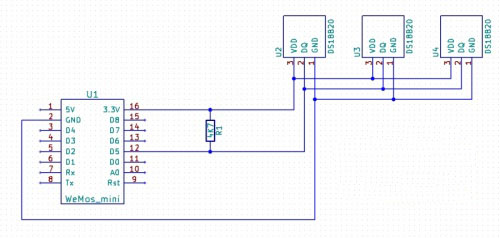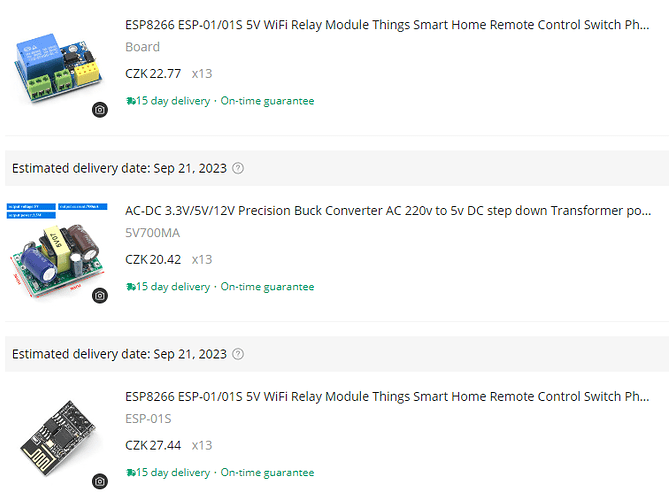Oh I see, yeah I have ordered the relay modules which use this so I hope this will be easier to install than this was
Oh yeah, its there

All of my devices run ESPHome which is well integrated into Home Assistant. All Dallas one-wire devices are digital and most have an ESPHome Sensor component.

In this example, each DS18b20 becomes an entity in Home Assistant.
Well…
Yes, adding this relay module into ESPHome (Home Assistant) is super easy. But. The ESP8266 is a 3.3V device and you ordered a 5V power supply.
I don’t see where we went from reading potentiometers to controlling relays. I use a few of those modules in my home, so like the ESP01 boards, it’s nice to have these in your parts kit as well.
Athom makes devices with ESPHome already flashed to the ESP chip. They are basically an ESP chip, a power supply, a relay, and a nice case. Here is one that might be what you need:
You just connect your line power on one side and what you want to turn on or off on the other. ESPHome is already installed, so all you need to do is give it your router credentials, then Home Assistant should “discover” it.
the board with relay is 3.7-12V and its much cheaper, but you are right, that is off topic
I couldn’t find that exact board on Ali Express (you posted a photo, not a link), but the ones I have that look like that don’t have a 3.3V regulator on-board.
BTW- stay away from Tuya devices unless you want to get really deep into the weeds flashing ESPHome or Tasmota to a non-ESP chip.
Yeah, sadly I have few Tuya devices at home from when I began my journey with smart home before I finally got my hands on Rpi so I am just using LocalTuya
This is the board and ESP modules that I bought
Tuya has switched to using the Realtek RTL8710BN Wi-Fi SOC instead of an ESP82xx chip. ESPHome or Tasmota cannot be flashed to Realtek devices.
There is a Tasmota-like interface that you can flash to the RTL8710BN chip then use with Home Assistant. Here are the instructions.
I second that statement! Tuya Is a dumpster fire, Stay Away!
Those esp01 relay modules are very handy, I used one to make my garage door opener smart and a few other places. Those things come in a few configurations too. There’s the relay obviously but they have some with dht-11 temp/humidity sensors and a couple others I believe. Personally, I prefer the D1-mini boards though. They’re only slightly larger and ypu can find “hats” for them. They make a relay hat, a dht hat, an lcd, a power supply hat with a barrel jack that you can power your boards with up to 12v. They have blank ones too where you can solder whatever sensor or circuits you want and then stack it on top of a d1 mini, they’re really cool.
If you search for Wemos D1 HATs, you will get “shields”.
HAT stands for 'hardware attached on top ’ and is specially designed for the Raspberry Pi Model B+ computers.
They are used interchangeably and as you pointed out, if you search for hats it will return results for shields just like if you added the word “attachment” so I’m not sure what your point is because any of those search terms will give them the same results. Good job!
You have a problem using the correct term? HATS were coined by the Raspberry developers. Just because Google conflates the terms doesn’t make it the correct use.
Someone “coining” an acronym doesn’t mean anything and you could find 50 other acronyms for “HAT”. They do not own the term, and it isn’t some proprietary component for raspberry, it’s a damn ACRONYM that’s widely used for other things and as I said, which you don’t understand. The two ARE used interchangeably which you yourself acknowledged by admitting BOTH search terms will return the same Hardware Attached on Top components based on which underlying board precedes “HAT” in your search term! HAT, Shield, Attachment, etc. These are ADJECTIVES and no one owns them whether you like it or not.
The concept of HATs and their associated guidelines is an established part of the Raspberry Pi ecosystem.
HAT (Hardware Attached on Top) refers to a standardized format and set of guidelines introduced by the Raspberry Pi Foundation. These guidelines were introduced to encourage consistency and ease of use for Raspberry Pi users and manufacturers of add-on boards.
The introduction of the HAT for Raspberry Pi add-on boards was about creating a standard and formalizing the process of designing and using these add-ons with Raspberry Pi. The Raspberry Pi Foundation introduced the concept of HATs to establish a set of guidelines and specifications that HAT manufacturers should follow. This includes requirements for the physical size and shape of HATs, as well as the use of an EEPROM (Electrically Erasable Programmable Read-Only Memory) chip to store configuration information, making HATs more plug-and-play with Raspberry Pi devices.
The guidelines for HATs (Hardware Attached on Top) in the Raspberry Pi ecosystem were introduced with the release of the Raspberry Pi Model B+ in July 2014. This model introduced a new expansion header called the “40-pin GPIO header,” which replaced the 26-pin header found on earlier models. The introduction of this 40-pin header was accompanied by the formalization of HAT specifications and guidelines by the Raspberry Pi Foundation.
Arduino Shields are defined and developed by the Arduino community and the Arduino ecosystem. Arduino Shields are expansion boards or modules that are designed to be compatible with Arduino microcontroller boards. They provide additional functionality, such as sensors, communication interfaces, displays, and more, to enhance the capabilities of Arduino-based projects.
Add-on boards for the BeagleBone family of single-board computers (SBCs) are commonly referred to as “Capes.”
Add-on boards for desktop PCs are called Expansion Cards or Peripheral Cards.
On minicomputers add-on boards are called Daughter Boards.
There is value in not using incorrect terminology. Just because Google expands searches into similar, but incorrect terminology, does not make it correct.
You can argue and keep trying to make your point with word salads that don’t actually make your point but instead reinforce what I keep saying. A company “coining” a term doesn’t mean they own it! Most of HATS or Shields are made by third parties or individual Makers now and sold under both names and the terms are used interchangeably not because I say so but, because that’s reality. The fact that you have some OCD disorder and don’t like it, that’s your problem. If it bothers you this much, why don’t you start emailing makers online, on Tindie, aliexpress, etc and make your case to the many of people who use the terms against your belief and you can make the case to them.
Hello again, everything I ordered arrived I managed to connect the realy modules so that is working and back to the potentiometers, I actually switch not to typical potentiometer but to basically button where you either push left, right or like normal button so I think I need 3 digital inputs for each so 9 in total, I looked at D1 mini pinout, (well ESP8266 pinout in general) reference and it has 9 digital pins but I am not sure I can use all of them. Can I connect basically 9 buttons to one ESP8266 board or do I need to use 2?
No, you can’t without port extender. ![]()
You can check the table on this site which pins have limitations and what are fit for Input and/or Output use ![]()
You can also use your arduino as port extender for a esp ![]()
Ok thank you but I will probably just use 2 D1 mini or is there a reason why it would be bad to do that?



